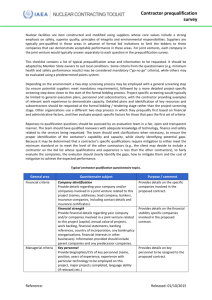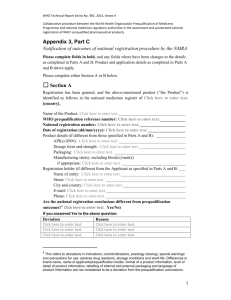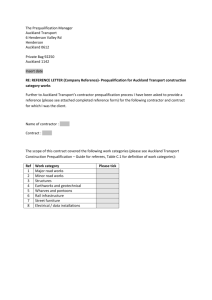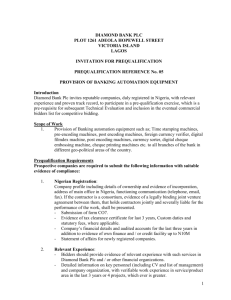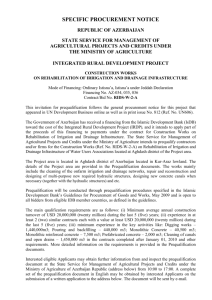- laschools.org
advertisement
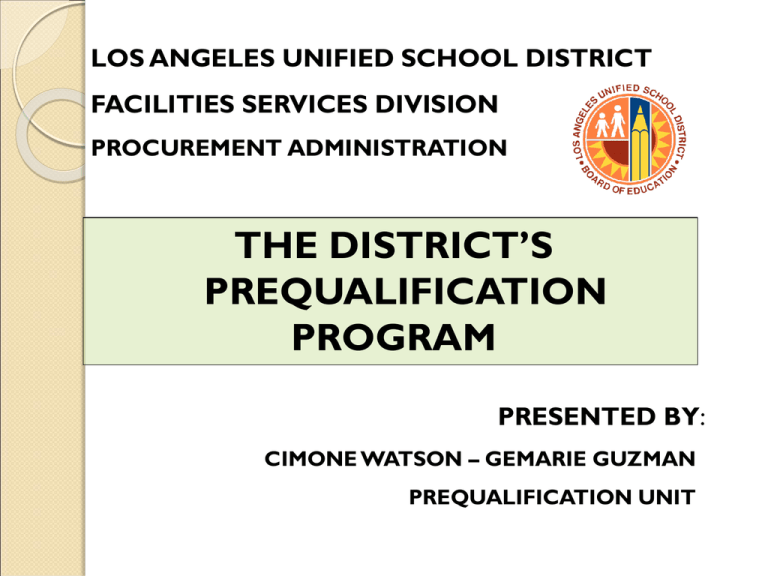
LOS ANGELES UNIFIED SCHOOL DISTRICT FACILITIES SERVICES DIVISION PROCUREMENT ADMINISTRATION THE DISTRICT’S PREQUALIFICATION PROGRAM PRESENTED BY: CIMONE WATSON – GEMARIE GUZMAN PREQUALIFICATION UNIT Prequalification Program It is the intent of the District to do business with quality contractors by identifying such contractors through a uniform system of rating bidders to obtain the best quality construction for the lowest price practicable under the circumstances. The District’s prequalification programs are adopted pursuant to Public Contract Code 20110 et seq. and 20919 et seq. Requires all contractors interested in bidding either formal or informal, competitively bid public works projects to prequalify before submitting a bid to the District Provides standard on-going prequalification enrollment for prospective bidders Prospective Bidders Interested in Bidding on INFORMAL District Projects: Informal District contracts, $83,400 or less, are bid through the Local District Maintenance & Operations Offices. Information on Informal contracts may be found on the LAUSD M & O Web Site @ http://mo.laschools.org/fis/existing-facilities/m-ando/bidwalks/ Contacts and telephone numbers to the Local M & O offices are located in the Construction Bidder’s Handbook Prospective bidders interested in bidding on Informal District contracts only need to be Safety prequalified. The Safety Questionnaire may be obtained by visiting the Prequalification website @ http://www.laschools.org/newsite/prequalification/forms. Fax completed Informal Questionnaires directly to Prequalification at 562-654-9498. Construction Contractor Safety Prequalification Contractor Applicant Overview For the LAUSD School Repair and Construction Program This presentation will walk you through the four sections of the Safety Prequalification Questionnaire. You have a copy of the Safety Questionnaire in your handouts and may begin filling it out as we go through this presentation. However, in most cases, you will not be able to complete the entire Questionnaire today. You will likely need to ◦ (a) contact your Insurance Carrier or Broker, and ◦ (b) review company files to complete the Questionnaire. IMPORTANT NOTE: The Safety Prequalification only applies to firms performing construction work for the School Repair and Construction Program. It does not apply to suppliers, vendors and service contracts. Prequalification is valid for one (1) year. Each firm must reapply prior to expiration. If your firm is seeking to renew, your firm’s safety and loss history will be considered during the renewal process. The Safety Questionnaire is the same for both Formal and Informal Prequalification. Basic Requirements Your firm must have a current and valid California Contractor’s License in good standing with the California State License Board. The name of the firm applying for Prequalification must be the same name that is on the license. Basic Requirements Your firm must have a current Workers’ Compensation insurance policy. The policy must be in the same name as the firm that is applying for Prequalification. • You will be required to provide proof of coverage in the form of a Certificate of Insurance. General Notes Fill in every blank. Write “N/A” if not applicable. Make sure your answers are legible. • If it can’t be read, it can’t be processed! Evaluation of your Questionnaire will not be completed until all information is complete and all fields are properly filled out. Do NOT send us anything we don’t ask for. Contractor Information Questionnaire Header Insurance Information Section A What is the EMR? The Experience Modification Rate (EMR) is a multiplier based on your firm’s Workers’ Compensation loss claim history that causes your insurance premiums to go up, or down. It impacts the cost of your firm doing business. Base Rate x EMR = Your insurance cost Where does EMR come from? The EMR is not calculated by your insurance broker or carrier. • California (intrastate) EMRs are calculated by the WCIRB (Workers Compensation Insurance Rating Bureau). • Interstate EMRs are calculated by NCCI (National Council on Compensation Insurance). In simple terms, the EMR is a ratio of actual claims dollars incurred by your firm compared to the industry average value for firms that do the same kind of work you do. ◦ Good history causes it to go down. ◦ Adverse history causes it to rise. It is desirable to have an EMR < 1.0. ◦ 1.0 is considered to be “average”. If you DON’T have an EMR: You must provide copies of your firm’s Workers’ Compensation Loss Runs for each of the last three years, along with your questionnaire. Contact your Insurance Carrier or Broker to obtain your Loss Runs. If you are a brand new company you will have neither an EMR nor loss runs. Please note this in writing on the questionnaire. What the EMR means to you: Let’s say you, Fred, are bidding against Joe and Bob. ◦ Your EMR is 1.0, ◦ Joe’s is 0.5, and ◦ Bob’s is 2.0. Let us also assume that your bids are identical with respect to time, material and labor hours, and include $10,000 as the manual (base) rate for Workers’ Comp. ◦ Your insurance would cost you $10,000. ◦ Joe would pay $5,000 for the same insurance. ◦ Bob would pay $20,000 for the same insurance. Who gets the job? ◦ JOE! Who says safety doesn’t pay? You can learn what your EMR is (if you have one) by contacting your Workers’ Compensation Insurance carrier. We will verify your answers. Applicant may be disqualified if either its (a) current EMR, or (b) average EMR for the most recent three-year period, is above 1.00, in which case, the District will determine, based on information submitted, whether Applicant has satisfied the requirements of Section A. Incidence Rates: Section B Enter one (1) NAICS code If you don’t know your firm’s NAICS Code, visit the Facilities Vendor Registration web site at: http://mo.laschools.org/lausd-vendor/register-ae Click on “View NAICS” to see a list of codes, or Type specialty trade in Primary box to get applicable code. Incidence Rates... …are based on employee injuries and illnesses and total company man-hours per CALENDAR YEAR, not insurance policy year. They: ◦ are not based on OSHA inspections or citations/violations. ◦ can be computed for every contractor EVEN IF THERE ARE NO OSHA ‘RECORDABLE’ CASES. A work-related injury or illness must be recorded if it resulted in: ◦ ◦ ◦ ◦ ◦ Death or dismemberment Loss of consciousness Days away from work Restricted work activity or job transfer Medical treatment beyond first aid Specific information on how to evaluate whether an incident is to be considered OSHA recordable can be found at www.osha.gov/recordkeeping Information Used for Calculating Incidence Rates Refer to your OSHA 300 Logs and/or your Loss Runs and injury/illness records to determine the number of injury cases you have incurred. Company hours is the total sum of all work hours by all employees (including those of a sole proprietor/owner) for the calendar year. Complete all information in this section of the questionnaire! Fill in every blank EVEN IF THE ANSWER IS “0.” Calculating Your Incidence Rates The formula used to calculate the incidence rates was established by the U.S. Department of Labor - Bureau of Labor Statistics. ◦ It’s been around for decades – it’s THE standard formula for everyone. Your rates are compared against the national average rates for your NAICS code. See Table 1 at http://www.bls.gov/iif/oshwc/osh/os/ostb3191.pdf When an employer calculates the company’s rates, the answer is a rate of incidents (injuries) per 200,000 hours (100 people working 8 hours a day, 50 weeks a year) - regardless of how many hours the contractor worked! Sample rate calculations: In 2006, a company has 1 OSHA recordable injury which did not involve lost workdays. The company worked 30,000 hours that year. ◦ The Total Case Incidence Rate is: (1 x 200,000) / 30,000 = 6.7 ◦ The Lost Workday Case Incidence Rate is: (0 x 200,000) / 30,000 = 0 ◦ The No Lost Workday Case Incidence Rate is: (1 x 200,000) / 30,000 = 6.7 A company has 4 OSHA recordable injuries in a 2008. Three cases were lost-workday injuries. One case did not involve lost workdays. The company worked 30,000 hours that year. ◦ The Total Case Incidence Rate is: (4 x 200,000) / 30,000 = 26.7 ◦ The Lost Workday Case Incidence Rate is: (3 x 200,000) / 30,000 = 20 ◦ The No Lost Workday Case Incidence Rate is: (1 x 200,000) / 30,000 = 6.7 If you are a new firm, please add a note on your forms that informs us of this. A new firm will be expected to have very few, or possibly no, company hours. We will verify this by checking the effective date of your Contractor’s License. OSHA Citation History Section C This section looks at your firm’s OSHA citation history. It considers 4 types of citations: ◦ serious ◦ willful ◦ failure to abate ◦ repeat. You must report all such citations that your firm has received. If you are contesting or appealing an applicable citation and it has not reached final resolution, you must still report the citation! The classification of the citation itself is important, but we also look at: ◦ what happened ◦ what corrective action was taken ◦ your firm’s safety program to see that it meets minimum Cal/OSHA and Labor Code requirements Citations are public information. Citation information for all employers is available using the “Establishment Search” at www.osha.gov Your answers will be verified. ◦ We will check back 60 months as stated in the Questionnaire! Safety Policy & Procedure Questions Section D Read each question carefully. The questions are based on Cal/OSHA and California Labor Code requirements. Understand what it is asking. ◦ The source regulation is listed with every question (Labor Code or Cal/OSHA). You may be required to provide documentation for any or all of your answers - be prepared! A “yes” answer implies that you have documentation available for review for that item if you are asked to provide it! Certification: You are responsible for the accuracy of the information! Still have questions? Here are some sources for additional information: Your firm’s Insurance Broker or Insurance Carrier Loss Control (Safety) Department, Cal/OSHA Consultation, Trade Associations your firm belongs to, Internet construction safety sources Construction Contractor Formal Prequalification Contractor Applicant Overview The Formal Prequalification Questionnaire Questionnaire is designed to thoroughly evaluate a contractor’s: Safety History Quality and Workmanship Past Performance Bonding/Insurance/Licensing Financial Capabilities Contractors Interested in Bidding on Formal District Projects: Complete the most current Prime Contractor Prequalification Questionnaire Have a current and active California Contractors License Receive and maintain Safety Approval via the Safety Prequalification section of the Questionnaire Meet the Mandatory and General Qualifications requirements Provide bonds by a California-admitted surety company Provide proof of Workers’ Comp and Liability coverage by an Insurance Company licensed to do business in California Provide references of projects completed within the last 36 months Submit a current audited or reviewed financial statement (SBE exemption) Prequalification approval is valid for one (1) year. THREE LEVELS OF PREQUALIFICATION BASED ON EXPERIENCE: Level I Entitled to bid on contracts in an amount not to exceed $350,000. Non-LAUSD experience: Within the past three (3) years, at least three (3) public or private works as either a prime contractor or a subcontractor with cumulative contract value totaling at least $500,000. LAUSD experience: Within the past three (3) years, at least three (3) LAUSD contracts as either a prime contractor or a subcontractor, with cumulative contract value totaling at least $100,000. Level II Entitled to bid on contracts in an amount not to exceed $5,000,000. Non-LAUSD experience: Within the past three (3) years, at least three (3) public or private works as either a prime contractor or a subcontractor with cumulative contract value totaling at least $2,000,000. LAUSD experience: Within the past three (3) years, at least three (3) LAUSD contracts as either a prime contractor or a subcontractor, with cumulative contract value totaling at least $500,000. Level III Entitled to bid on contracts in an amount in excess of $5,000,000. Non-LAUSD experience: Within the past three (3) years, at least three (3) public or private works as either a prime contractor or a subcontractor with cumulative contract value totaling at least $10,000,000. LAUSD experience: Within the past three (3) years, at least three (3) LAUSD contracts as either a prime contractor or a subcontractor, with cumulative contract value totaling at least $7,000,000. Prequalification Scoring Contractor performance history will be measured according to two separate components, Field and Compliance. Field Component (Maximum Score 50, Passing Score 35) ◦ Average score of Contractor Performance Evaluations for the last three (3) contracts. ◦ Applicant must receive an average score of at least 35 points to prequalify. Compliance Component (Maximum Score 50, Passing Score 35): 1. Labor Compliance 2. Project Stabilization Agreement (PSA) 3. Bid Issues/Protests 4. Assessments 5. Failure to comply with LAUSD contract Warranty requirements For details, see Field and Compliance Scoring Summary on the Prequalification web page at http://www.laschools.org/new-site/prequalification/special-forms QUESTIONS???
